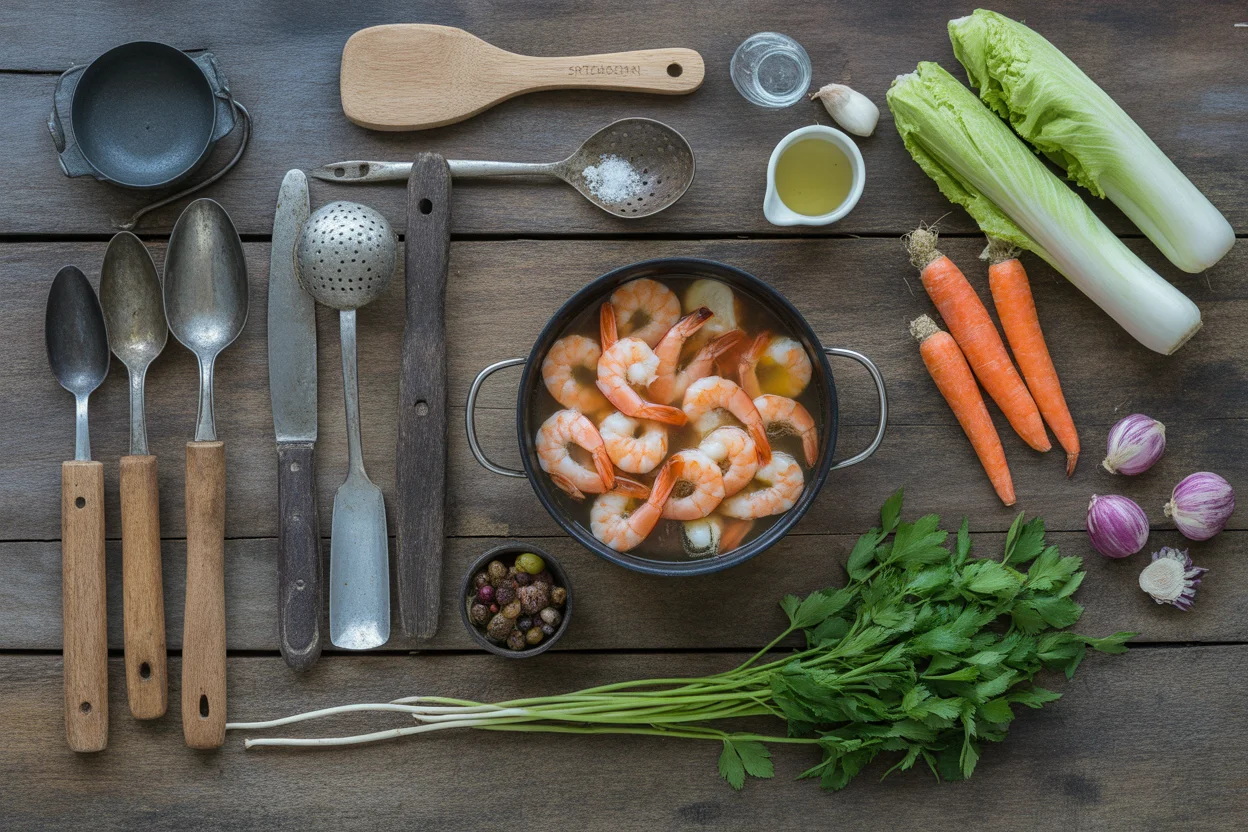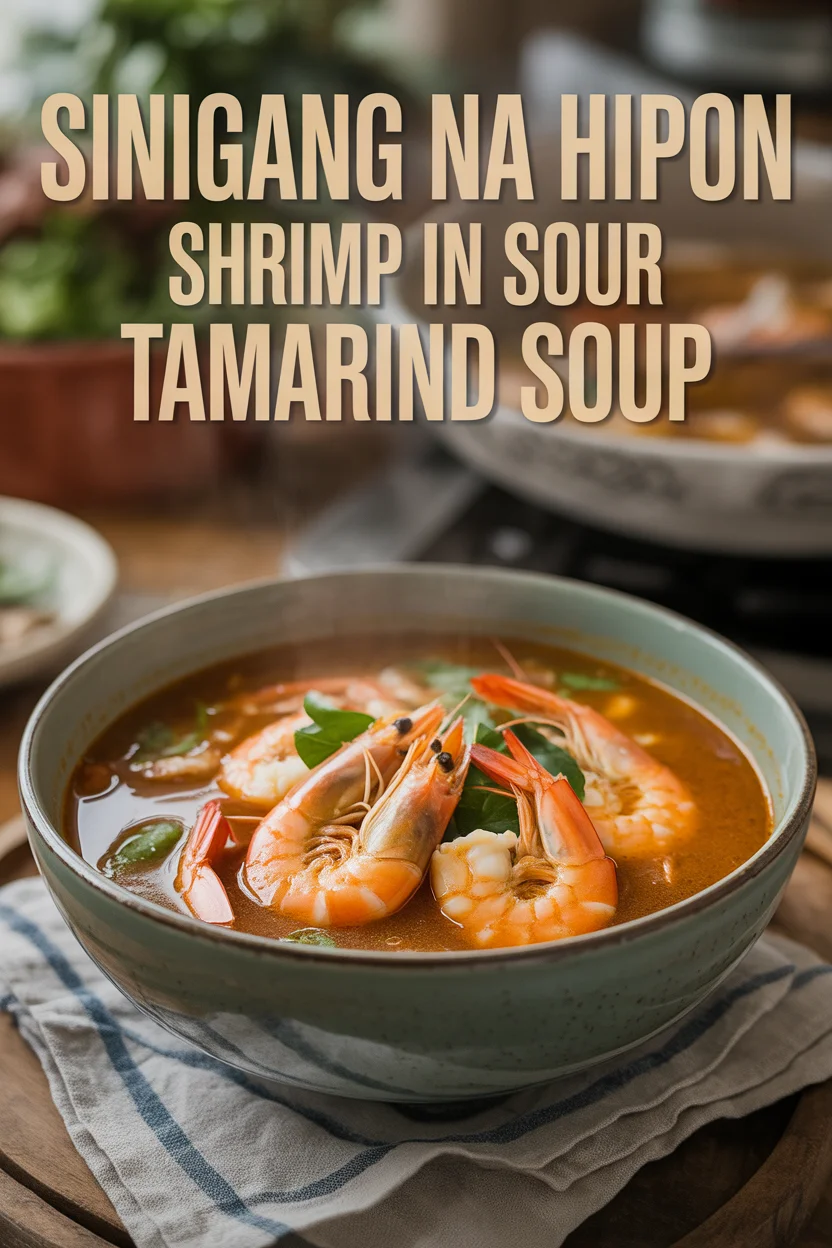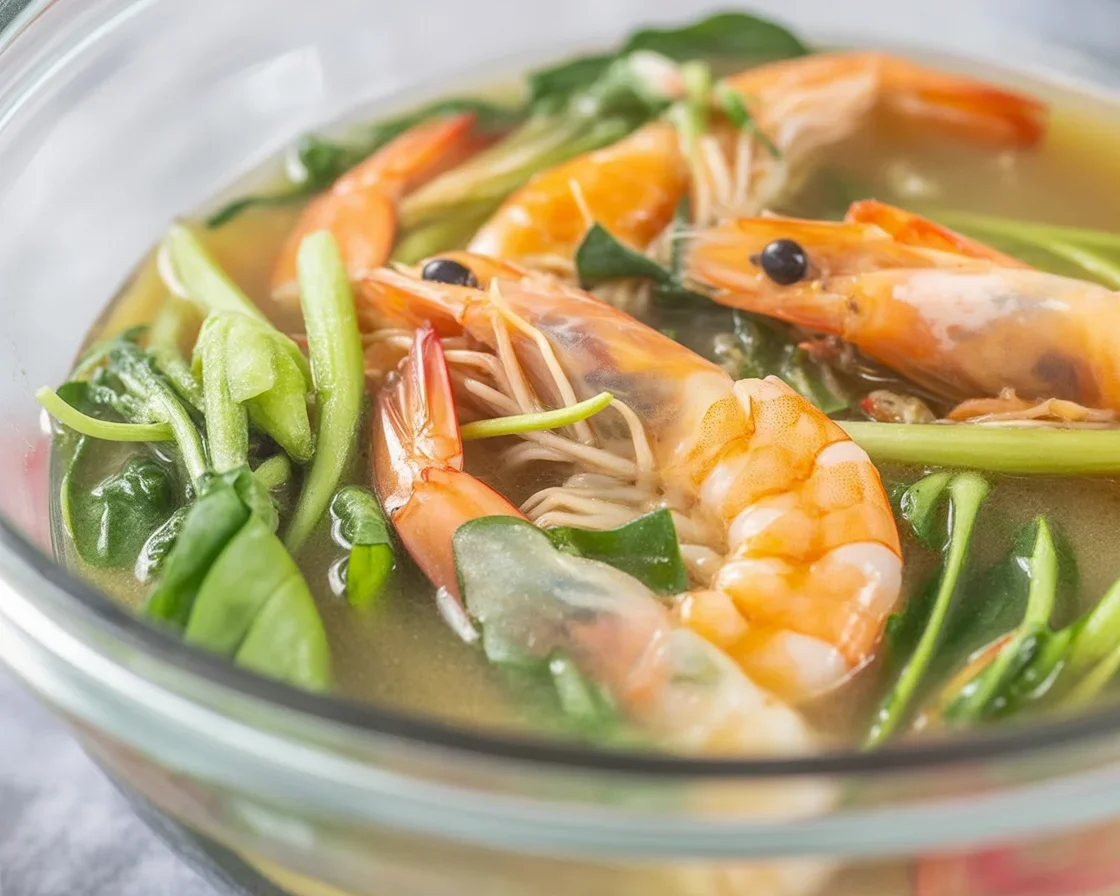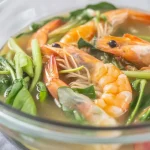Filipino sinigang na hipon is that dish you crave when you’re worn out, stressed, or just need a full-body wake-up. I mean, how many soups out there slap you awake and hug you at once? Not many. Picture this—it’s pouring outside. You want something bright, tangy, and quick to make. Suddenly you remember sinigang na hipon. Lucky you, it’s not fussy at all. Whenever friends visit, especially expats, this always lands on my table. Weird as it sounds, it turns even picky eaters into fans. By the way, if you love those comforting Filipino classics, you might also want to try my absolute favorites like this garlic sinangag Filipino garlic fried rice or even join the crowd over at the traditional Filipino bulalo beef bone marrow soup post. Anyways, let’s get into sinigang na hipon—shrimp in sour tamarind soup—that’s food for your soul for real.
Overview of sinigang na hipon
Sinigang na hipon is not just another Filipino soup, it’s a noisy family lunch in a bowl. It’s got shrimp swimming in a tart tamarind broth with veggies that soak up all that flavor. This is not the kind of meal that pretends to be subtle. It’s mouth-puckering, lots of umami, and somehow makes rice the best thing ever invented (again).
If you grew up in the Philippines, just smelling this soup probably reminds you of rainy season afternoons (ugh, those muggy days). But don’t worry, you don’t need a secret ingredient—just shrimp, some souring agent (tamarind is top-tier), and any leftover veg in your fridge. Honestly, it’s forgiving. You’ll probably nail it even on your first try.
Some people ask me if there’s a “real” sinigang na hipon recipe. Nope, everyone’s Nanay does it different. But that’s the fun part. Last month, I made it with eggplant and green beans but, you know, one tita added okra—that’s legit, too.
There’s something soothing about eating sinigang na hipon hot and steamy with a bowl of rice. You get comfort and zing all at once. If you want to dive deeper into why Filipinos love this tangy dish, see what sinigang says about Filipino culture.
Preparing shrimp
Alright, let’s talk shrimp. First, fresh is best—always. Frozen works in a pinch, but nothing beats plump shrimp straight from the wet market (or, fine, a decent grocery).
Here’s a big debate: do you peel them or leave them in their shells? My stance? Keep the shells! That’s where the flavor lives. The heads are full of rich, briny taste and they make the broth extra shrimpy. Bit messy to eat, but isn’t that what spoons are for? Besides, you can always peel a few for easy nibbling, but leave most intact.
Now, give those shrimp a quick rinse under cold water. Pull off the whiskery bits and, if you’re up for it, use a little knife to devein them. Nobody likes that gritty bite (gross). Still, in some Filipino kitchens, leaving the vein is standard and no one complains.
Don’t over-marinate or season the shrimp before they go in. They’ll soak in all the goodness from the broth later. Oh, and always cook them last—shrimp gets tough if it hangs in the soup too long. Fast cooking, that’s the secret. 
Cooking tamarind broth
Here’s where the magic happens. The broth is the soul (yep, I’m dramatic) of sinigang na hipon. Start by boiling water with fresh tamarind if you’re doing things old school, but most days I reach for those sinigang mix packets—convenient, can’t lie.
If you’re using real tamarind, just boil the pods until soft, squish them (with your bare hands or a spoon, whatever’s less messy), and strain out seeds. You’ll get this tangy, cloudy juice that wakes up your whole kitchen.
Once your water or broth simmers, toss in onions and tomatoes. Let them soften so all the flavors blend. Later you’ll add your veggies and, finally, the shrimp. Timing matters here; too long in the pot and shrimp goes rubbery. I once forgot them for, like, five minutes. Disaster. Learn from my mistake!
Taste as you go. Sometimes I add more tamarind mix if it’s not sour enough. Don’t stress. Adjust to make your tongue happy.
Adding vegetables
Veggies are the backbone of sinigang na hipon. The classics are sitaw (long beans), radish, eggplant, and okra, but honestly, I just grab whatever’s on hand. Water spinach (kangkong) is a sure hit if you can find it—you want leafy greens to soak up the tang.
Chop everything in bite-sized pieces so they cook evenly. I add the harder ones first: radish goes in right after the broth is bubbling, followed by eggplant and sitaw. The leafy ones always come last because they wilt super quick.
Carrots work too (yeah, non-traditional but try it). Throw in a green chili if you like it hot—my uncle used four once, he’s wild. Please adjust before someone in the family starts to sweat uncontrollably at the table.
Veggies should be tender but not mushy. Quick tip: don’t walk away while it cooks. Or you’ll come back to a vegetable graveyard. Happened to me. Twice.
Seasoning
Seasoning is where sinigang na hipon gets personal. I start with a pinch of salt and a few drops of fish sauce—patis—the stuff is pungent but adds that special punch. Some folks add Maggi, others a sprinkle of pepper. Totally up to you.
Don’t overdo it. The shrimp and vegetables add enough flavor already. You’re just rounding it out. Need more salt? Add a little. Want more zip? A pinch more of that tamarind powder goes a long way. (Watch out. Too much and you’ll pucker so hard your face hurts. Speaking from experience.)
I keep a dipping sauce of patis and crushed red pepper on the side for that extra salty vibe. I know, borderline obsessive, but hey, it’s tradition. Taste before serving every single time. Your tongue never lies.
“I grew up eating sinigang na hipon almost every Sunday. Nothing beats that perfect mix of sour broth and briny shrimp, especially with a big scoop of garlic rice. My kids complain if I make anything else!”
— Maricel, longtime soup lover
Serving hot
Best advice: eat sinigang na hipon immediately after cooking. The shrimp stays juicy, and the broth is at its zingiest. If you let it sit, the shrimp can go rubbery (no one wants that). This is not a “let’s have leftovers” soup, honestly.
Here are a few fun ways to serve it up:
- Spoon directly over steaming rice (the only right way, if you ask me).
- Pair with garlic sinangag Filipino garlic fried rice for breakfast — wild, but delicious.
- Next to Filipino tinola with spinach chicken if you want a soup fest.
- With Filipino pork BBQ with banana ketchup glaze at a summer BBQ party.
Don’t forget tiny bowls for dipping sauce. And napkins. This gets messy, fast.
Flavor tips
Want your sinigang na hipon to taste like you ordered it from a five-star restaurant (yes, I said it)? Here are a few oddball but genius tips. Don’t skip.
First, if you can snag shrimp heads, use them. Just crush a few heads into the pot for turbo flavor. It’s a grandma move and makes a difference. Second, swap tamarind with green mango or calamansi sometimes. You’ll get a different kind of sharp, which is super fun. Third, go easy on the stirring—shrimp breaks apart faster than you think.
If your family likes a spicier kick, a couple whole green chilies tossed in the pot do the trick. My neighbor adds a few tomatoes by mistake—they loved it and never went back.
And don’t be scared to experiment with your vegetables. Even a chunk of corn on the cob can work in a pinch (pinky promise).

Looking to master sinigang na hipon or want to peek at other home cooks’ techniques? Check out this classic Sinigang na Hipon Recipe and see how Sinigang na Hipon (Shrimp in Sour Soup) – Foxy Folksy puts their spin on it. And if you’re chasing that extra wow factor, the walk-through by Shrimp Sinigang (Sinigang na Hipon) | Iankewks is a life-saver. Try it, edit it, make mistakes—sinigang na hipon is a forgiving soup, and honestly, that’s why we love it.
Sinigang na Hipon
Ingredients
For the Shrimp
- 1 kg fresh shrimp, preferably with shells Fresh is best, but frozen works in a pinch.
For the Broth
- 8 cups water Use more if needed to adjust broth quantity.
- 1 pack sinigang mix Or use fresh tamarind boiled until soft.
- 1 medium onion, quartered Adds sweetness to the broth.
- 2 medium tomatoes, quartered Enhances the flavor.
For the Vegetables
- 2 pieces radish, sliced Adds a crunchy texture.
- 1 piece eggplant, sliced Traditionally used in sinigang.
- 100 g sitaw (long beans), cut Adds variety and nutrition.
- 100 g okra, cut Optional, can be added for texture.
- 1 bunch water spinach (kangkong) Add leafy greens towards the end of cooking.
- green chili, whole Optional, for added heat.
Seasonings
- 2 tsp salt Adjust according to taste.
- 2 tbsp fish sauce (patis) Adds depth of flavor.
- 1 tsp pepper To taste.
Instructions
Preparation
- Rinse the shrimp under cold water and devein if desired, keeping the shells for flavor.
- Boil water in a large pot.
Cooking
- If using fresh tamarind, boil until soft, then strain to extract juice; otherwise, add tamarind mix directly.
- Add onion and tomatoes to the boiling water, cooking until softened.
- Add radish, cooking for 2-3 minutes, followed by eggplant and sitaw.
- Finally, add the water spinach and green chili, cooking for just a minute.
- Add shrimp and season with salt and fish sauce; cook until shrimp turn pink and opaque.
Serving
- Serve sinigang na hipon hot over steaming rice or as a standalone soup.
- Pair with dipping sauce of fish sauce and crushed red pepper.

